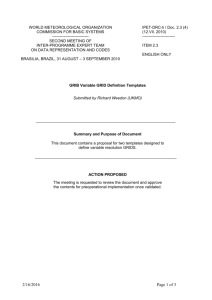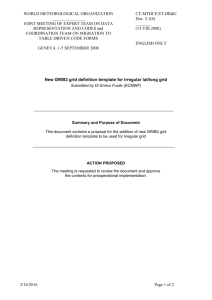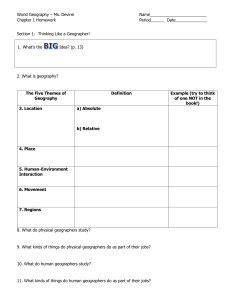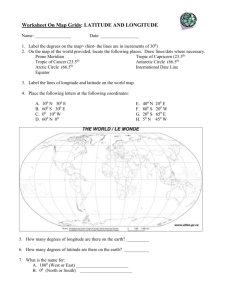WORLD METEOROLOGICAL ORGANIZATION
advertisement
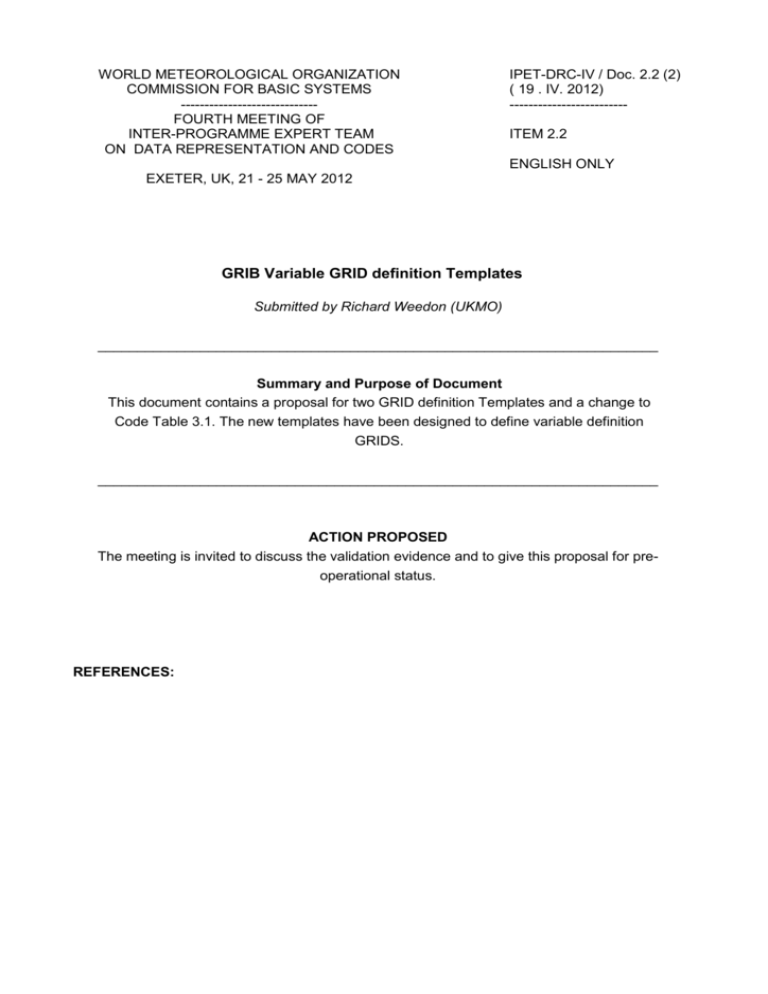
WORLD METEOROLOGICAL ORGANIZATION COMMISSION FOR BASIC SYSTEMS ----------------------------FOURTH MEETING OF INTER-PROGRAMME EXPERT TEAM ON DATA REPRESENTATION AND CODES IPET-DRC-IV / Doc. 2.2 (2) ( 19 . IV. 2012) ------------------------ITEM 2.2 ENGLISH ONLY EXETER, UK, 21 - 25 MAY 2012 GRIB Variable GRID definition Templates Submitted by Richard Weedon (UKMO) _______________________________________________________________________ Summary and Purpose of Document This document contains a proposal for two GRID definition Templates and a change to Code Table 3.1. The new templates have been designed to define variable definition GRIDS. _______________________________________________________________________ ACTION PROPOSED The meeting is invited to discuss the validation evidence and to give this proposal for preoperational status. REFERENCES: BACKGROUND AND DISCUSSION The Met Office produces data on variable resolution grids, such as our UKV domain. These grids have rows of constant latitude and columns of constant longitude, each with irregular spacing. We wish to store the latitude and longitude of every row and column, and propose two new Grid Definition Templates to store such fields. PROPOSAL Two new entries in code table 3.1: Code Table 3.1: Number 4 5 Grid Definition Template Number Meaning Variable resolution latitude/longitude Variable resolution rotated latitude/longitude Comments Two new Grid Definition Templates Grid Definition Template 3.4: Octet Number(s) 15 16 17-20 21 22-25 26 27-30 31-34 35-38 39-42 43-46 47 48 49-ii (ii+1)-jj Notes: (1) Variable resolution latitude/longitude Contents Shape of the earth (see Code Table 3.2) Scale factor of radius of spherical earth Scaled value of radius of spherical earth Scale factor of major axis of oblate spheroid earth Scaled value of major axis of oblate spheroid earth Scale factor of minor axis of oblate spheroid earth Scaled value of minor axis of oblate spheroid earth Ni - number of points along a parallel Nj - number of points along a meridian Basic angle of the initial production domain (see Note 1) Subdivisions of basic angle used to define extreme longitudes and latitudes, and direction increments (see Note 1) Resolution and component flags (see Flag Table 3.3 and Note 2) Scanning mode (flags see Flag Table 3.4) List of longitudes (see Notes 1 and 3) List of latitudes (see Notes 1 and 3) Basic angle of the initial production domain and subdivisions of this basic angle are provided to manage cases where the recommended unit of 10-6 degrees is not applicable to describe the longitudes and latitudes. For these descriptors, unit is equal to the ratio of the basic angle and the subdivisions number. For ordinary cases, zero and missing values should be coded, equivalent to (2) respective values of 1 and 106 (10-6 degrees unit). The resolution flag (bit 3-4 of Flag table 3.3) is not applicable. (3) (4) The list of Ni longitudes and Nj latitudes shall be coded in the octets immediately following the Grid Definition Template in octets 49 to ii and octets ii+1 to jj respectively, where ii = 48 + 4Ni and jj = 48 + 4Ni + 4Nj A scaled value of radius of spherical Earth, or major or minor axis of oblate spheroid Earth is derived from applying appropriate scale factor to the value expressed in metres. Grid Definition Template 3.5: Variable resolution rotated latitude/longitude 15-48 Same as grid definition template 3.4 (see Note 1) 49-52 Latitude of the southern pole of projection 53-56 Longitude of the southern pole of projection 57-60 Angle of rotation of projection (see Note 4) 61-ii List of longitudes (see Notes 1 and 3) (ii+1)-jj List of latitudes (see Notes 1 and 3) Notes: (1) (2) Basic angle of the initial production domain and subdivisions of this basic angle are provided to manage cases where the recommended unit of 10–6 degrees is not applicable to describe the longitudes and latitudes. For these descriptors, the unit is equal to the ratio of the basic angle and the subdivisions number. For ordinary cases, zero and missing values should be coded, equivalent to respective values of 1 and 106 (10–6 degrees unit). Three parameters define a general latitude/longitude coordinate system, formed by a general rotation of the sphere. One choice for these parameters is: (a) The geographic latitude in degrees of the southern pole of the coordinate system, e.g θp; (b) The geographic longitude in degrees of the southern pole of the coordinate system, e.g λp; (c) The angle of rotation in degrees about the new polar axis (measured clockwise when looking from the southern to the northern pole) of the coordinate system, assuming the new axis to have been obtained by first rotating the sphere through λp degrees about the geographic polar axis, and then rotating through (90 + θp) degrees so that the southern pole (3) (4) moved along the (previously rotated) Greenwich meridian. For the list of Ni longitude bounds and Nj latitude bounds at the end of the section ii = 60 + 4Ni and jj = 60 + 4Ni +4Nj Regulation 92.1.6 applies
